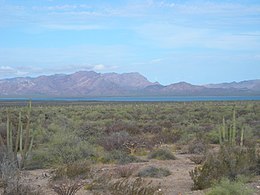Tiburón Island
Native name: Tahejöc | |
|---|---|
 View of Tiburón Island across Infiernillo Channel, south of Punta Chueca | |
 | |
| Etymology | Spanish word meaning 'shark' |
| Geography | |
| Location | Gulf of California |
| Coordinates | 28°59′20″N 112°22′23″W / 28.98889°N 112.37306°W |
| Archipelago | Islas Grandés |
| Area | 1,201 km2 (464 sq mi) |
| Administration | |
| State | Sonora |
| Demographics | |
| Population | 0 |
| Languages | Seri (formerly) |
| Ethnic groups | Seri (formerly) |
| Additional information | |
| Time zone |
|
Tiburón Island is the largest island in the Gulf of California and the largest island in Mexico, with an area of 1,201 square kilometres (464 sq mi).[1] It was made a nature reserve in 1963 by President Adolfo López Mateos.[2][3][full citation needed]
Etymology
Tiburón is Spanish for 'shark'. Although the Seri name, Tahejöc, was first recorded by Alphonse Pinart in 1879,[4] its etymology is unknown.

Geography
Tiburón Island is part of the Mexican state of Sonora, as well as the Hermosillo Municipality, and is located at approximately the same latitude as the city of Hermosillo. It is located along the eastern shore of the Gulf of California, opposite Isla Ángel de la Guarda. It is part of the chain of islands known as the Midriff Islands or Islas Grandes.
The island has a prominent mountain system of volcanic origin.
History
Tiburón Island is part of the traditional homeland of some bands (or clans) of the Seri people, for many centuries if not millennia.[5] During the 1960s and early 1970s, a small hunting and fishing camp on the northern end of the island was operated by Jesus Olivas, a resident of Hermosillo. He constructed several buildings, a dock and an airstrip near the historic Seri encampment at Tecomate. The camp was popular with American visitors to the area. The remains of the structures and airstrip are still in place (although the airstrip was rendered unusable by the Mexican military around 1995 in an attempt to keep it from being used by smugglers active in the area at the time). The Mexican government, through a decree by President Echeverría, gave the Seri "recognition and title of communal property" (reconocimiento y titulación de terrenos comunales) with respect to Tiburón Island in 1975.[2]
The island is uninhabited (except for Mexican military encampments on the eastern and southern shores of the island) and is administered as an ecological preserve by the Seri tribal government in conjunction with the federal government. Bighorn sheep were introduced to the island in the 1980s;[6] hunting is managed by the tribal government in coordination with Mexican federal authorities. It is also home to a unique subspecies of coyote (Canis latrans jamesi)[7] and mule deer (Odocoileus hemionus sheldoni)[8] that are endemic to the island.
Transportation
The island can be reached from Punta Chueca, which is the nearest community inhabited by members of the Seri tribe, and from Bahía de Kino, a non-Seri community 34 kilometres (21 miles) to the south. The distance from Punta Chueca to Punta Tormenta, the nearest point on the island, is 3 kilometres (1.9 miles). The channel between the mainland and the island is called Canal del Infiernillo ('Tiny Hell's Channel') because of the strong tidal currents and shoal water that occur there which can make navigation challenging.

Recreation
Two permits are required for day hiking and overnight stays on the island: one from the Seri Governor's office in Punta Chueca and another from the ISLAS office in Bahía de Kino.
In popular culture
In 2012, two television episodes of Survivorman were filmed on Tiburón Island, featuring Les Stroud as he spends ten days living on the island.[9] Mermaids of Tiburon is a 1962 film about a diver looking for buried treasure who comes across mermaids.
See also
Notes
- ^ "Superficie Continental e Insular del Territorio Nacional" [Continent and Island Surface of the National Territory] (in Spanish). INEGI. Archived from the original on 2007-08-17.
- ^ a b "Decreto por el que se crea la Comisión de Desarrollo de la Tribu Seri del Estado de Sonora, con el objeto de promover el desarrollo integral de dicha comunidad" [Decree for the creation of the Seri Tribe Development Commission of the State of Sonora, with the objective of promoting the all-around development of that community.]. Diario Oficial de la Federación (in Spanish). SEGOB. 11 February 1975. Archived from the original on 2020-09-17.
- ^ Comisión de Desarrollo de la Tribu Seri. (1976) Tribus de Sonora: Los seris. Hermosillo, Sonora.
- ^ Pinart, Alphonse Louis. "Seri Vocabulary" (4 April 1879) [Manuscript]. Bureau of American Ethnology, File: Manuscript 1146, ID: NAA.MS1146, pp. 27. Washington, D.C.: National Anthropological Archives, Smithsonian Institution.
- ^ Moser, Edward W. (1963). "Seri Bands". Kiva: Journal of Southwestern Anthropology and History. 28 (3). Arizona Archaeological and Historical Society: 14–27. doi:10.1080/00231940.1963.11757641.
- ^ Festa-Bianchet, M. 2020. Ovis canadensis. The IUCN Red List of Threatened Species 2020: e.T15735A22146699. https://dx.doi.org/10.2305/IUCN.UK.2020-2.RLTS.T15735A22146699.en. Downloaded on 10 April 2021.
- ^ Bekoff, Marc (15 June 1977). "Canis latrans". Mammalian Species (79): 1–9. doi:10.2307/3503817. JSTOR 3503817.
- ^ "Odocoileus hemionus sheldoni". Integrated Taxonomic Information System. Retrieved 16 September 2020.
- ^ Stroud, Les (2016). "Survivorman – Season 5". Official Survivorman Website. Archived from the original on 2020-09-17.
External link
![]() Media related to Tiburón Island at Wikimedia Commons
Media related to Tiburón Island at Wikimedia Commons



